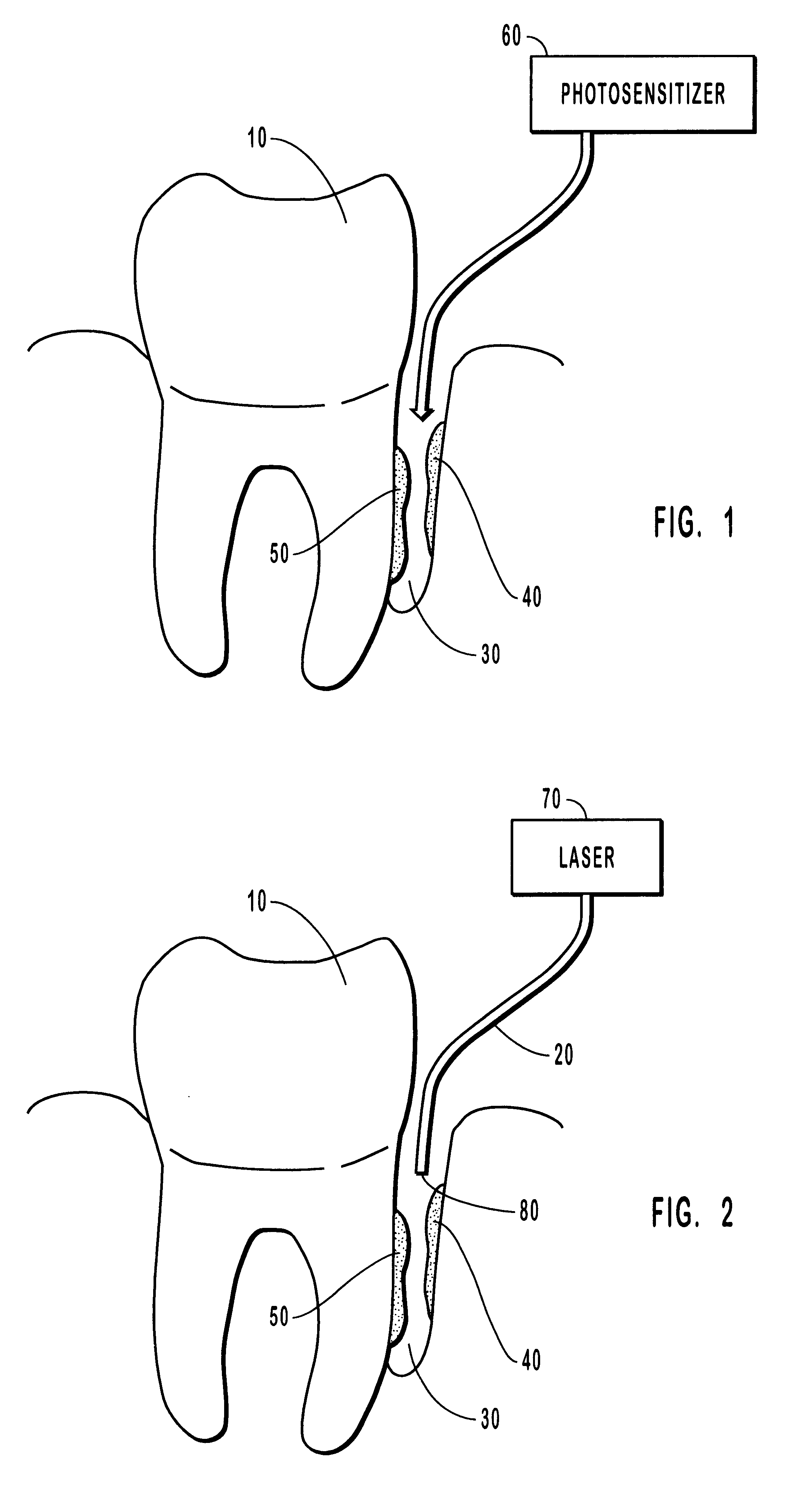Methods for treating periodontal disease
a periodontal disease and laser technology, applied in the field of periodontal disease treatment methods, can solve the problems of less able to focus tissue-destroying effects within a desired area of long-wavelength light, more energy and time is and the use of laser energy of a shorter wavelength significantly reduces the time and energy required to heat a given area of tissu
Inactive Publication Date: 2003-05-06
ANDERSEN SCOT N +1
View PDF22 Cites 92 Cited by
- Summary
- Abstract
- Description
- Claims
- Application Information
AI Technical Summary
Benefits of technology
Because of the dye composition's light absorption characteristics, it absorbs the laser light, which selectively heats and destroys the stained bacteria and surrounding necrotic tissue, thus forming a coagulate and / or char. The coagulate or char formed by the procedure is removed as it adheres to the fiber tip of the laser by simply removing and cleaning the fiber tip as needed. Depending on the size of the diseased area, it may be necessary to remove and insert the fiber tip a number of times in order to remove all of the coagulate or char formed during destruction of the bacteria and necrotic tissue. Removal and insertion of the fiber tip may also serve to score (i.e., damage) the freshly exposed tissue, thus stimulating growth and readhesion of the tissue to the tooth.
Problems solved by technology
The result is that longer wavelength light is less able to focus the tissue-destroying effect within a desired area.
Moreover, because the energy penetrates more deeply, more energy and time is required to heat a given area.
Hence, the use of laser energy of a shorter wavelength significantly reduces both the time and energy required to heat a given area of tissue.
Accordingly, the use of dyes greatly decreases the time and energy necessary to heat a given area of tissue.
Method used
the structure of the environmentally friendly knitted fabric provided by the present invention; figure 2 Flow chart of the yarn wrapping machine for environmentally friendly knitted fabrics and storage devices; image 3 Is the parameter map of the yarn covering machine
View moreImage
Smart Image Click on the blue labels to locate them in the text.
Smart ImageViewing Examples
Examples
Experimental program
Comparison scheme
Effect test
example 2
A dye composition for use in the methods according to the invention was made that included the following components:
example 3
A dye composition for use in the methods according to the invention was made that included the following components:
example 4
A dye composition for use in the methods according to the invention was made that included the following components:
the structure of the environmentally friendly knitted fabric provided by the present invention; figure 2 Flow chart of the yarn wrapping machine for environmentally friendly knitted fabrics and storage devices; image 3 Is the parameter map of the yarn covering machine
Login to View More PUM
| Property | Measurement | Unit |
|---|---|---|
| Nanoscale particle size | aaaaa | aaaaa |
| Wavelength | aaaaa | aaaaa |
| Wavelength | aaaaa | aaaaa |
Login to View More
Abstract
Methods for treating periodontal disease and other diseased tissues that utilize a dye composition and laser energy. The laser energy (typically about 450 nm to about 600 nm) heats and destroys the diseased tissue and bacteria, while the dye composition causes the laser energy to be selectively absorbed by the targeted tissue. An argon gas laser that emits blue-green light may be used in conjunction with a red-orange dye that strongly absorbs light energy emitted by the argon gas laser. An 810 diode laser may be used in conjunction with the argon laser in order to provide additional heating properties.
Description
1. The Field of the InventionThe present invention relates generally to methods for treating periodontal disease, particularly to methods that utilize laser energy to destroy necrotic tissue and bacteria that have been stained with an appropriate dye.2. The Relevant TechnologyIt is well known that periodontal disease is caused by bacteria that grows and festers within the periodontal pocket. Porphyromonas gingivalis and other bacteria host not only in the soft tissue around the periodontal pocket, but also in plaque that is formed on the surface of the tooth. If left untreated, such bacteria can cause swelling of the gingiva, pain and possible loss of the tooth. Surrounding gums and teeth can also become infected.In the conventional treatment of periodontal disease, instruments are inserted into the periodontal pocket to mechanically debride the plaque from the tooth and also to remove the necrotic soft tissue by curettage. Antibiotics may also be conventionally placed in the period...
Claims
the structure of the environmentally friendly knitted fabric provided by the present invention; figure 2 Flow chart of the yarn wrapping machine for environmentally friendly knitted fabrics and storage devices; image 3 Is the parameter map of the yarn covering machine
Login to View More Application Information
Patent Timeline
 Login to View More
Login to View More IPC IPC(8): A61K31/635A61K31/63A61K31/015A61K31/01A61Q11/00A61K31/473A61K8/41A61K8/46A61K8/49A61K41/00
CPCA61N5/062A61K8/466A61K8/498A61K31/015A61K31/473A61K31/635A61K41/0057A61N5/0603A61N5/0624A61Q11/00A61K8/411A61C1/0046A61K2800/81A61N2005/0606A61N2005/0631A61N2005/067A61N5/067
Inventor ANDERSEN, SCOT N.WILSON, JIMMY B.
Owner ANDERSEN SCOT N
Features
- R&D
- Intellectual Property
- Life Sciences
- Materials
- Tech Scout
Why Patsnap Eureka
- Unparalleled Data Quality
- Higher Quality Content
- 60% Fewer Hallucinations
Social media
Patsnap Eureka Blog
Learn More Browse by: Latest US Patents, China's latest patents, Technical Efficacy Thesaurus, Application Domain, Technology Topic, Popular Technical Reports.
© 2025 PatSnap. All rights reserved.Legal|Privacy policy|Modern Slavery Act Transparency Statement|Sitemap|About US| Contact US: help@patsnap.com

